American
-
Detlor - Song for Eric Dolphy - Flute (or Alto Flute) Alone
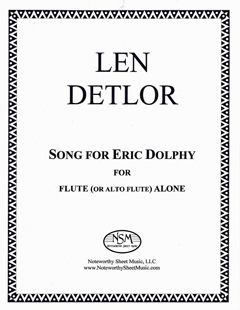 Song for Eric Dolphy, by Len Detlor
Song for Eric Dolphy, by Len DetlorEdited and with a Preface by Peter H. Bloom
Contemporary Composition for Flute (or Alto Flute) Alone, $14.15
Mr. Bloom, in his Preface to Song for Eric Dolphy, writes: "Len Detlor (1941-2008) was an
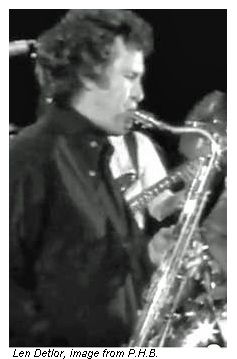 extraordinary artist whose creative vision, masterful technique, and depth of humanity transcended medium and category. As a composer, saxophonist and flutist, arranger, and music director, he was devoted to musical expression that was both elegantly structured and unconstrained." Len Detlor composed this evocative piece as a tribute to the legendary saxophonist, clarinetist, and flutist Eric Dolphy (1928-1964), whose recordings remain highly influential across musical genres and generations.
extraordinary artist whose creative vision, masterful technique, and depth of humanity transcended medium and category. As a composer, saxophonist and flutist, arranger, and music director, he was devoted to musical expression that was both elegantly structured and unconstrained." Len Detlor composed this evocative piece as a tribute to the legendary saxophonist, clarinetist, and flutist Eric Dolphy (1928-1964), whose recordings remain highly influential across musical genres and generations.Flute part, 7 pages; Total, 10 pages.
Preview
-
Dieter - The Golden “Reade” Flute - Flute & Piano
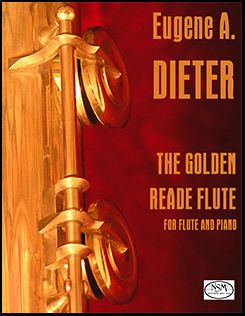 The Golden "Reade" Flute, by Eugene A. Dieter
The Golden "Reade" Flute, by Eugene A. DieterFlute Part and Piano Score ― PDF $7.99
Elmer Reade (1898-1986), to whom The Golden "Reade" Flute is dedicated, served a long and distinguished career, first as a flutist with the U.S. Army Band and then as a conductor and music director of the Air Force Band at Mitchell Field, New York. Eugene A. Dieter graduated from the first class of the US Army Music School in 1941 and was appointed a bandmaster. Following the Second World War, Dieter accepted a bandmaster position with the Air Force Band and remained active until his retirement in 1966. Likely, it was as an Air Force band colleague of Elmer Reade's that Dieter was inspired to compose The Golden "Reade" Flute. (excerpted from the foreword © by P. H. Bloom)
Not at all militaristic in character, The Golden "Reade" Flute is more a lovely barcarole, a single Andante moderato movement in 6/8 time. It offers interesting writing for both parts, so flutist and pianist will be equally pleased. The title refers to the gold flute by William S. Haynes upon which Reade regularly performed.
Piano score, 4 pages; Flute part, 2 pages.
Preview -
Finlayson - 3 Pagan Dances - Percussion Ensemble
3 Pagan Dances, by Walter A. Finlayson
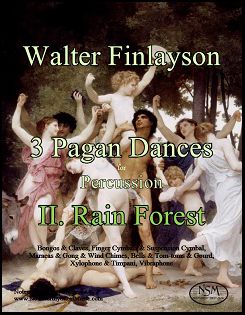 Contemporary Compositions for Percussion Ensemble
Contemporary Compositions for Percussion Ensemble
I. Goddess of the Earth: Score and Parts, PDF $8.99
II. Rain Forest: Score and Parts, PDF $6.99
III. Temple of the Sun: Score and Parts, PDF $13.99
Noteworthy Sheet Music's chief editorial consultant Peter H. Bloom received Walter Finlayson's previously-unpublished score for 3 Pagan Dances from the composer's daughter, and we were delighted for the opportunity to become acquainted with this rousing, intoxicating work. For our publications, we've opted to create separate editions for the three pieces, giving players the choice of acquiring only one or two of the 3 Pagan Dances at a time, depending on their level of interest and performance needs. In each case we have maintained the composer's allocation of instruments per player. Pagan Dance I. Goddess of the Earth is scored for (1) snare drum/suspension cymbal/gong, (2) tom-toms, (3) temple blocks/xylophone/cowbell, (4) bells, (5) chimes, and (6) timpani. Pagan Dance II. Rain Forest is scored for (1) bongos/claves, (2) finger cymbals/suspension cymbal, (3) maracas/gong/wind chimes, (4) bells/tom-toms/gourd, (5) xylophone/timpani, and (6) vibraphone. Pagan Dance III. Temple of the Sun is scored for (1) xylophone, (2) tom-toms, (3) temple blocks, (4) gong/suspension cymbal, (5) chimes/crash cymbal, and (6) timpani. Our editions of the 3 Pagan Dances include both scores and parts.
Click on the MP3 icons below to listen to audio samples from a 1964 performance of the work:
I. Goddess of the Earth audio
 II. Rain Forest
II. Rain Forest III. Temple of the Sun
III. Temple of the Sun
We at NSM are pleased to aid in the re-discovery of some of Walter Finlayson's compositions; for additional biographical information about this remarkable composer, please visit the Our Composers page.Preview I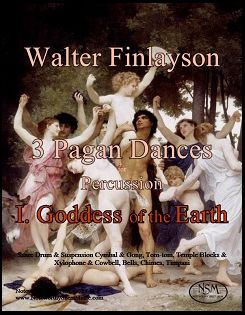 I. Goddess of the Earth: Score, 8 pages; Parts for (1) snare drum/suspension cymbal/gong, (2) tom-toms, (3) temple blocks/xylophone/cowbell, (4) bells, (5) chimes, and (6) timpani, 1 page each; Total, 16 pages
I. Goddess of the Earth: Score, 8 pages; Parts for (1) snare drum/suspension cymbal/gong, (2) tom-toms, (3) temple blocks/xylophone/cowbell, (4) bells, (5) chimes, and (6) timpani, 1 page each; Total, 16 pages II. Rain Forest: Score, 6 pages; Parts for (1) bongos/claves, (2) finger cymbals/suspension cymbal, (3) maracas/gong/wind chimes, (4) bells/tom-toms/gourd, (5) xylophone/timpani, and (6) vibraphone, 1 page each; Total, 14 pages.
II. Rain Forest: Score, 6 pages; Parts for (1) bongos/claves, (2) finger cymbals/suspension cymbal, (3) maracas/gong/wind chimes, (4) bells/tom-toms/gourd, (5) xylophone/timpani, and (6) vibraphone, 1 page each; Total, 14 pages.
Preview II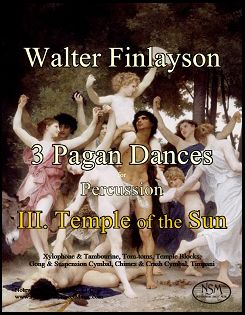 III. Temple of the Sun: Score, 13 pages; Parts for (1) xylophone, 2 pages, (2) tom-toms, 2 pages, (3) temple blocks, 2 pages, (4) gong/suspension cymbal, 1 page, (5) chimes/crash cymbal, 1 page, and (6) timpani, 2 pages; Total, 26 pages.
III. Temple of the Sun: Score, 13 pages; Parts for (1) xylophone, 2 pages, (2) tom-toms, 2 pages, (3) temple blocks, 2 pages, (4) gong/suspension cymbal, 1 page, (5) chimes/crash cymbal, 1 page, and (6) timpani, 2 pages; Total, 26 pages.
Preview III -
Finlayson - Moon Shadows - Winds and Percussion
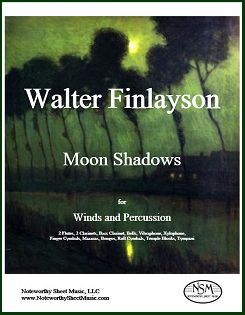 Moon Shadows, by Walter A. Finlayson
Moon Shadows, by Walter A. FinlaysonContemporary Composition for 2 Flutes, 2 Clarinets, Bass Clarinet, and 9 Percussion Instruments
Score and Parts, PDF $14.25
Walter Finlayson (1919-2000) was an American composer, musician, educator, and music innovator, with nearly twenty original compositions and some forty arrangements to his credit. While serving in the navy, he played saxophone and clarinet in the US Naval Reserve dance band, seated next to the great Artie Shaw. Finlayson's ASCAP output includes music for band, dance band, orchestra, voice, and chorus. His compositions and arrangements have been published by Boosey & Hawkes, EB Marks, Boston Music, and Mercury Music, and performed by major college marching band programs. One of his best-known compositions is I Had a Premonition, which was written for voice and piano, but which was later arranged for the Jimmie Lunceford Orchestra, one of the preeminent bands of the swing era. A recording of the tune can be heard on The Jimmie Lunceford Collection: 1930-47 compact disc released in 2014 on the Fabulous label, and on YouTube.
Noteworthy Sheet Music's chief editorial consultant Peter H. Bloom received Finlayson's previously-unpublished score for Moon Shadows from the composer's daughter, and we were impressed with its quality and sophistication. For a piece written in the late 1930's or early 1940's, as Gale Finlayson recollects (the score is not dated), Moon Shadows seems remarkably ahead of its time. The work is scored for two flutes, two clarinets, bass clarinet, bells, vibraphone, xylophone, finger cymbals, maracas, bongos, roll cymbals, temple blocks, and tympani. We notated our modern edition of the piece as faithfully as possible based on the hand-written Finlayson score; our edition of Moon Shadows includes both score and parts. We at NSM are pleased to aid in the re-discovery of some of Walter Finlayson's works; for additional information about this interesting composer, please visit the Our Composers page under About Us.
Score, 19 pages; Parts for Flute-1, Flute-2, Clarinet-1, Clarinet-2, Bass Clarinet, Bells, Vibraphone, Xylophone, Finger Cymbals and Maracas, Bongos and Roll Cymbals, Temple Blocks, and Tympani, 1 page each; Total, 34 pages.
Preview -
Foster - Old Folks; Oh! Susanna - Vo/Pf/Fl/Vc
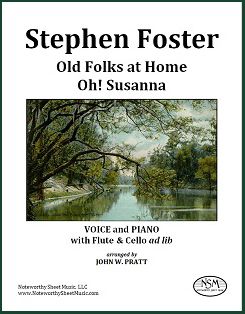 Old Folks at Home and Oh! Susanna, by Stephen Foster
Old Folks at Home and Oh! Susanna, by Stephen FosterArranged with Flute and Cello ad lib by John W. Pratt
Flute Parts, Cello Parts, Voice Parts, and Piano Scores ― PDF $7.99
The following excerpts are taken from John W. Pratt's foreword to the edition:
When a Golden Oldie comes to mind, Doo-dah! Doo-dah!
Comic, sad, or any kind, Oh! Doo-dah-day!
Jeanie, Swanee, Kentucky, Joe, Doo-dah! Doo-dah!
Beautiful, dreamy, fast, or slow, Oh! Doo-dah-day!
I'll bet I know who wrote it, he wrote them night and day,
Stephen Foster wrote it, he'll never go away.
Stephen Foster was born in Lawrenceville, Pa., on July 4, 1826...He wrote over 200 songs, including 135 parlor songs, 28 minstrel songs, and 21 hymns and Sunday school songs. A remarkable number are memorable, as the ditty above will attest to anyone with anything like my background. One wonders why. The harmonies and rhythms are basic, as are the forms and rhyme schemes (see above), the music is repetitious, and the vocal range rarely goes outside an octave (a great benefit for community singing). Yet the fit is so natural and the pacing so well judged that the songs are ideally effective and diabolically catchy. Foster is perhaps, though on a different plane, the Mozart of his field...
For a pianist playing several stanzas at a sing-along, Foster's songs do become a little dull. But their very simplicity, repetitiousness, and familiarity abet variation as, again on a different plane, chorales serve Bach chorale preludes. Like chorale preludes, the piano parts here always incorporate the melody, so they can be played solo or to accompany amateur singers. It struck me that they could be enhanced by optional flute parts. After writing them, I discovered that, according to his brother Morrison, Foster himself "delighted in playing accompaniments on the flute...As the song went on he would improvise...the most beautiful variations upon its musical theme." If Foster's improvisations were like the one his brother published, however, they just varied the melody itself in the manner of the period. My game is more ambitious, as you will easily see. I added optional cello parts, mostly for color, as in the Haydn trios but superficially more interesting for the cellist. (Again we are on a different plane, of course.)
"Oh! Susanna," one of the best-known American songs by anybody, is Foster's "Erlkönig." (Speak of different planes!) With its nonsensical lyrics and polka beat, it is clearly comical, and I treated it accordingly. It was written in Cincinnati, possibly for a social club, first performed at an ice cream saloon in Pittsburgh in 1847, and published in 1848. When no American song had sold over 5,000 copies, it sold over 100,000. It earned Foster only $100, but its popularity led to a publisher's offer, convincing him to become a professional songwriter, America's first.
"Old Folks at Home" established Foster as a truly American composer. It was written in 1851 for a blackface troupe whose leader paid Foster about $15 to be credited for it. When almost finished, Foster asked his brother for "a good name of two syllables for a Southern river." He rejected Yazoo and Pedee, but was delighted with Swanee, a shortening of Suwanee, a small river in Florida which his brother found in an atlas. Though about a slave's nostalgia for home, I find its theme universal and melancholy and I resisted the temptation to jazz it up. Please try, at least, a slowish tempo.
― John W. Pratt, May 27, 2013 ©
Flute parts, 2 pages; Cello parts, 2 pages; Voice parts, 2 pages; Scores, 7 pages; Total, 18 pages.
Preview -
Gifford - The Pied Piper of Hamelin - An Operetta
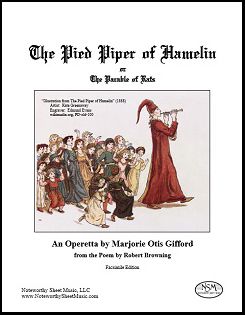 The Pied Piper of Hamelin, by Marjorie Otis Gifford
The Pied Piper of Hamelin, by Marjorie Otis GiffordAn Operetta, from the Poem by Robert Browning
Facsimile Edition by Noteworthy Sheet Music, LLC, PDF $24.99Marjorie Otis Gifford (1909-2003) was a composer, choirmaster, and long-time music and piano teacher in CT and NY. At age 24, she put music to Robert Browning's classic poem The Pied Piper of Hamelin, creating a children's operetta for her students. In her preface to the operetta, Mrs. Gifford states that perhaps the best performance of The Pied Piper was at the Lenox School in NYC, where she was teaching in 1938; that production was directed by Antoinette Perry, who later became known as 'Tony' of the Tony Awards. Indeed, there are additional famous personalities and much fascinating history associated with the remarkable life of Marjorie Otis Gifford.
The Pied Piper of Hamelin operetta was brought to NSM's attention by Gale Finlayson, daughter of composer and music educator Walter Finlayson, and we created our facsimile edition of the operetta at Gale's request. Marjorie Otis Gifford and Walter Finlayson were great friends, and in her preface Mrs. Gifford credits Mr. Finlayson with putting her operetta down on paper. NSM has received permission to publish the operetta from both the executor of Mrs. Gifford's estate and from Deborah O'Connor, the artist who created the charming illustrations that grace the internal pages of the operetta. We hope that, in publishing our facsimile edition, we can contribute to sustaining the legacy of Marjorie Otis Gifford and enabling future generations of young music students to perform and enjoy her work.
Marjorie Otis Gifford's The Pied Piper of Hamelin operetta was performed by the Rutland Youth Theatre of Rutland, VT, on March 2, 2018; click the link to visit YouTube and watch clips of this performance videotaped and posted by Ms. Finlayson.
Score with music and lyrics for voices and piano accompaniment, 67 pages; text of the Robert Browning poem addendum, 7 pages; Total, 78 pages.
PreviewPlease use the Contact Us link to order The Pied Piper of Hamelin operetta PDF. Upon receiving your request, we will send you an invoice via PayPal and, once PayPal acknowledges receiving your payment, we will email a copy of the PDF to you directly.
-
Lane - Danzas Mecánicas - Wind Quintet
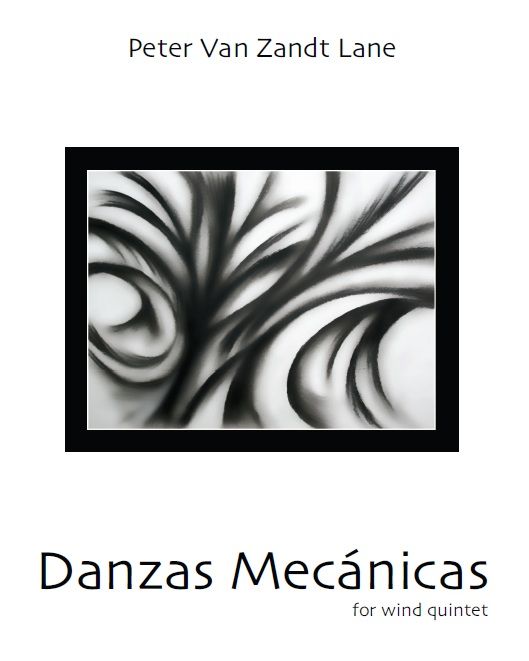 Danzas Mecánicas, by Peter Van Zandt Lane
Danzas Mecánicas, by Peter Van Zandt LaneContemporary Composition for Wind Quintet, PDF $30.00
Peter Van Zandt Lane is a Boston-based composer and bassoonist. His compositions have been performed across the United States, as well as in Europe and South America, by acclaimed musicians and ensembles such as The Cleveland Orchestra, SIGNAL, International Contemporary Ensemble, Dinosaur Annex, New York Virtuoso Singers, Triton Brass, Xanthos Ensemble, East Coast Composers Ensemble, EAR Duo, Quux Collective, and NotaRiotous. He has written for chamber ensemble, wind ensemble, orchestra, and choir, and often employs the use of electronics in his works.
Lane's Danzas Mecánicas - for woodwind quintet (2011) is an exciting 3-movement, 10-minute piece of fairly high difficulty scored for flute, oboe, clarinet, horn, and bassoon. A recording of the piece performed by the Solar Winds Quintet at Slosberg Hall, Brandeis University, in October, 2013 can be heard on YouTube.
Score, 26 pages; Parts, 49 pages; Total, 78 pages.
Preview -
Lane - Seven Rants - Wind Quintet & Piano
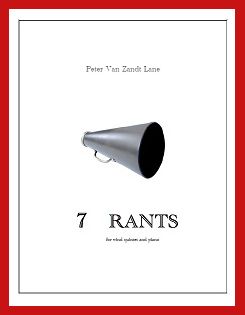 Seven Rants, by Peter Van Zandt Lane
Seven Rants, by Peter Van Zandt LaneContemporary Composition for Flute, Oboe, Clarinet, Horn, Bassoon, and Piano, PDF $0.00
Peter Van Zandt Lane was commissioned to compose this piece for the 67th Composers Conference and Chamber Music Workshop at Wellesley College, which took place in the summer of 2011. The annual Conference is a wonderful two-week event, which brings together prominent young composers, superb professional musicians, dedicated amateur chamber musicians, and enthusiastic listeners. The professional musicians premiere the composers' new works and also coach the amateur musicians in chamber ensembles. Concerts are free and open to the public. For more information on the program, please visit the Composers Conference website.
After the Conference each year, one of the composer fellows is selected to create a new work for the next year's chamber music workshop participants. That composer returns the following summer to coach two groups of players on the new composition, in preparation for performances in the Saturday evening concerts of Week I and Week II. Peter Van Zandt Lane's Seven Rants was an enormous success in 2011, absolutely loved by the players and received exceptionally well by the audience. Written for flute, oboe, clarinet, horn, bassoon, and piano, Seven Rants is a series of seven delightful and diverse movements. The first and last movements are strict palindromes. The five middle movements or "rants" are "mini-concertos", each highlighting a different wind instrument. Great fun to play, and highly accessible.
With permission from both the composer and the Wellesley Composers Conference and Chamber Music Center, Noteworthy Sheet Music is thrilled to offer our customers a free PDF download of Seven Rants by Peter Van Zandt Lane. And please check out more of this terrific young composer's work, including two other listings in the NSM catalog, Danzas Mecánicas and Transverse Fractures.
Score, 37 pages: Flute part, 10 pages; Oboe part, 9 pages; Clarinet part, 10 pages; Horn part, 9 pages; Bassoon part, 9 pages; Piano part, 15 pages; Total, 103 pages.
-
Lane - Transverse Fractures - Flute & Piano
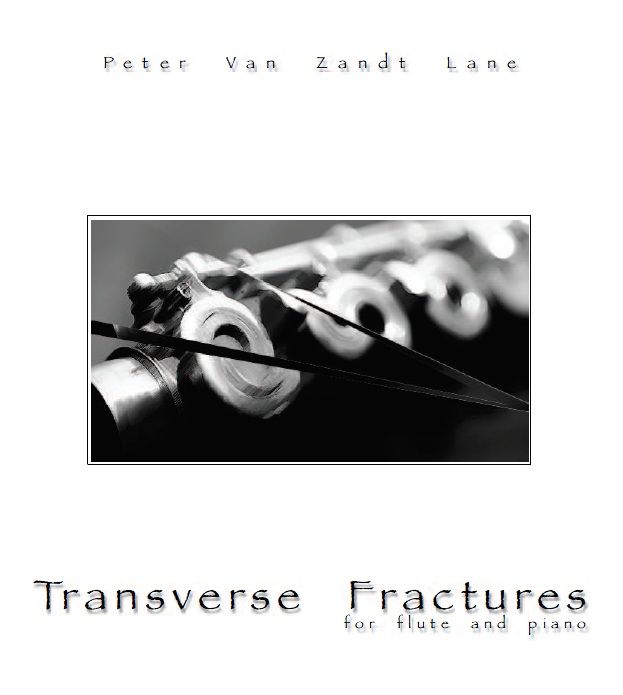 Transverse Fractures, by Peter Van Zandt Lane
Transverse Fractures, by Peter Van Zandt LaneContemporary Composition for Flute and Piano, PDF $20.00
Peter Van Zandt Lane's compositions have been featured on various festivals and conferences such as the New York City Electroacoustic Music Festival, Spark Festival, FEASt Fest, SEAMUS National Conferences, Forecast Music, Festival Miami, and LIPM/IEMS at the world renowned Teatro Colón in Buenos Aires. He has received awards in several competitions including the CRS Young Composers competition, the Forecast Music International Composers Competition, The Greater Miami Youth Symphony Composition Competition, and the Cleveland Orchestra Miami Residency Call for Scores. He has been a finalist twice for the ASCAP/SEAMUS Student Commission, and is an active member of the Composers in Red Sneakers, one of the country's longest-running composer consortiums.
Transverse Fractures (2009) is a short, virtuosic, high-energy duet for flute and piano. The piece was derived from a larger, longer chamber work entitled Partial Fractures, which the composer wrote for NotaRiotous Ensemble. Transverse Fractures, approximately 5 minutes long, is a piece of considerable difficulty for both the flutist and the pianist.
Piano Score, 13 pages; Flute Part, 7 pages; Total, 23 pages.
Preview -
Li Qi - Fog - Flute Alone
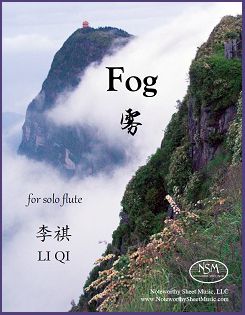 Fog, by Li Qi
Fog, by Li Qi
Contemporary Composition for Solo Flute, PDF $5.99Fog was written in 2012 by the up-and-coming young composer Li Qi. In addition to receiving other projects and awards, Li Qi was selected by the Wellesley Chamber Music Workshop to compose the program's commissioned piece for 2016, An Autumn Dusk in the Mountains for flute1, flute2/alto flute, cello, and piano.
Short, interesting, and challenging, Fog will appeal to advanced flutists and their audiences. Inspired by the poem "Stray Birds" by Rabindranath Tagore, the piece strives to capture in a musical way the recurring interplay between fog and sunlight, as a representation of the circle of life with all its sorrow, joy, and continuously-unfolding beauty. A recording of a 2012 performance of Fog by Heath White at the Jacobs School of Music, Indiana University, has been posted on YouTube; please click the link to listen.Our front cover image is from Wikimedia Commons: "The Mount Emei" by pookieevans (CC BY-SA 2.0).
Preview
Flute part, 3 pages; Total, 7 pages.
-
Loeffler - 4 Poèmes - Clarinet (Voice, Clarinet and Piano)
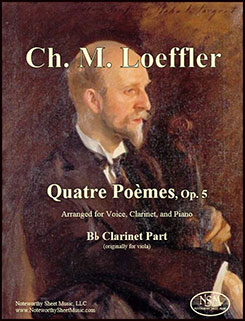 Quatre poèmes pour voix, alto et piano, by Charles Martin Loeffler
Quatre poèmes pour voix, alto et piano, by Charles Martin LoefflerViola part transcribed for Clarinet by C.A.Vater
Part for B-flat Clarinet; PDF $10.99
Noteworthy Sheet Music’s transcription of the viola part for Brahms’ Two Songs for Alto, Viola, and Piano, Op. 91 for clarinet quickly became one of our most popular editions, so we wanted to please our customers with another voice, clarinet, and piano option. We decided to create a clarinet version of the poems famously set to music by Charles Martin Loeffler (1861-1935). Quatre Poèmes pour Voix, Alto et Piano, Op. 5 was premiered by the Boston Symphony Orchestra with Loeffler himself on viola. In these four songs, Loeffler set to music one poem by Charles Baudelaire (“La cloche fêlée”) and three poems by Paul Verlaine (“Dansons la Gigue!”, “Le son du cor s’afflige vers les bois”, and “Sérénade”). Each of these songs has a unique character but Loeffler’s love of color variations and dense harmonies can be heard throughout the set.
We have taken care to adapt the viola part to the clarinet as conservatively as possible, and we think it works well. Obviously, there are places where we had to make modifications, and occasionally some difficult choices—for example where the viola has double stops, goes out of clarinet range, or uses harmonics or pizzicato. We encourage clarinetists who plan to perform this piece to listen to recordings of these songs with viola, and to consult the original viola part and score, available as free PDF downloads from imslp.org. Our edition includes only the transcribed clarinet part.B♭-Clarinet part, 10 pages; Total, 14 pages.
Preview
-
McDonald - Three Four-Note Flute Duets - Two Flutes
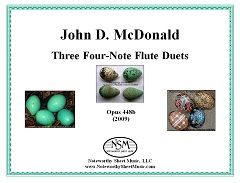 Three Four-Note Flute Duets, Op.448b, by John D. McDonald
Three Four-Note Flute Duets, Op.448b, by John D. McDonaldContemporary Composition for Two Flutes, PDF $2.99
"Composed for Ethel Farny and her flute students at the Rivers Music School, these short duets sprout initially from the first flute/violin duet of Several Strands, Op. 448a. This Grazioso is indeed made from only four pitches. Similarly, Murmurando confines itself to a four-note knot until its final dyad. The third duet, Con Eleganza, stretches the four-note concept a bit more. Each instrument has its own four-pitch pattern, and a coda leaves the four-note idea behind all together, concluding the set with six slower, somewhat more chromatic bars that could very well lead to future music of more emotional complexity. Perhaps there will be more duets to come." ― John McDonald, November 2009
John McDonald is a member of The Mockingbird Trio, directs the Tufts Composers Concert Series, and serves on the boards of several performance organizations in New England. He has recently fulfilled commissions from The Chamber Orchestra of Boston, pianist David Holzman, The Firebird Ensemble (for an Apple Hill Center for Chamber Music Residency, with support from a Meet the Composer MetLife Creative Connections Award), and the ANA Trio (Fredonia University; soprano, cello, and piano), among others. Recent performances by McDonald at the Goethe Institut of Boston, at Tufts, and at many other venues have been highly acclaimed.
Score for Two Flutes, 2 pages; Total, 4 pages.
-
McDonald - Three Melodies That Descend - Flute
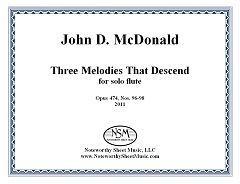 Three Melodies That Descend, Op.474, Nos.96-98 by John D. McDonald
Three Melodies That Descend, Op.474, Nos.96-98 by John D. McDonaldContemporary Composition for Solo Flute, $2.99
John McDonald is Professor of Music at Tufts University, where he served as Director of Graduate Music Studies from 2000 to 2010 and Department Chair from 2000 to 2003. He was named the 2007 MTNA—Shepherd Distinguished Composer of the Year by the Music Teachers National Association, and received the 2009 Lillian and Joseph Leibner Award for Distinguished Teaching and Advising from Tufts University. In 2010, he received the Waring Prize from Western Reserve Academy, the highest award given to alumni of that school. His recordings appear on the Albany, Archetype, Boston, Bridge, Capstone, Neuma, New Ariel, and New World labels, and he has concertized widely as composer, pianist, and collaborative performer. New releases include pianist Andrew Rangell's performance of McDonald's Meditation Before A Sonata: Dew Cloth, Dream Drapery, on Bridge Records.
McDonald's Three Melodies That Descend, Op.474, Nos.96-98 were written for composer and flutist Joshua Hahn after his graduation from Tufts University in May 2011. They work on the principle that what starts high must come down, and they are also a foil to the Eleven Melodies That Go Up In Different Ways (Op. 474, Nos. 30-40).
Flute part, 2 pages; Total, 4 pages.
-
Nelson - Play of Light - Flute & Harp
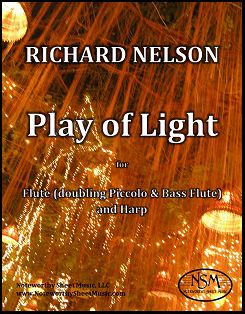 Play of Light, by Richard Nelson
Play of Light, by Richard Nelson Contemporary Composition for Flute (doubling piccolo & bass flute) and Harp
Score and Flute Part, PDF $15.25
Play of Light, for flute and harp, was written for the duo "2" (Peter H. Bloom and Mary Jane Rupert). The piece is built around spaciousness, transparency, multi-hued shadings and playful chases. The incorporation of bass flute and piccolo further enhances the inherently rich color possibilities of the flute/harp combination—the three flute instruments in succession form a sort of "super-flute" in the work's final section.
Drawing on his jazz and improvisation background, composer Richard Nelson in this composition leads the players into a substantial section that they complete through improvisation. While they follow signposts on intensity, energy and pitch content that he provides, this practice nonetheless creates an element of intrigue and unpredictability that the composer values highly. It also assures that each performance of the piece will have a strongly individual profile.
The Duo "2" artists have released a studio recording ofPlay of Light, available free of charge; please click the link to listen to the audio file on the composer's SoundCloud site.
Peter H. Bloom gave a lecture on “Effective Writing for Flutes and the Contemporary Flutist” at the 2018 Snow Pond Composers Workshop. In his presentation, Mr. Bloom discussed various topics using four contemporary works published by Noteworthy Sheet Music, including Play of Light, as examples. We later published a free text version of this excellent presentation on our website, in the Reviews and Articles section, including some of the audio clips and supplemental written materials that Mr. Bloom used as demonstrations.
Score, 23 pages; Flute part, 9 pages; Total, 36 pages.
Preview==========================================================
We also offer a print version of Play of Light by Richard Nelson, for those who prefer to purchase the work as a professionally-printed hard copy. Due to prohibitively high international shipping rates, we ship print editions only to addresses in the USA. The cost of the hard copy edition of Play of Light is $25.93, plus a $5.95 shipping and handling fee. Please use the Contact Us form to let us know which print publication(s) you would like to purchase, along with your email contact information and USPS mailing address. We will then send you a PayPal invoice for the sale and, once we receive notice from PayPal that you have paid for the item(s), we will ship your music to the address provided for delivery in 7-10 business days. -
Robichaux - Recurrence - Flute & Piano
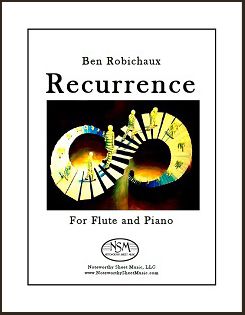 Recurrence, by Ben Robichaux
Recurrence, by Ben RobichauxContemporary Composition for Flute and Piano
Flute Part and Piano Score, PDF $12.99
NSM welcomed composer Ben Robichaux as a new contributor to our catalog in early June, 2017, when we published his piece Recurrence for flute and piano. For details of Mr. Robichaux's background, interests, and other works, please click the link to access the Composers section of the NSM website.
Recurrence was written for the composer's friend Michael Lyons. As outlined in the program notes, the "duet is framed in a traditional rondo form: ABACA. The returns of the A theme are never literal returns and repeated materials among the differing sections are never identical repetitions. These returns of A are the inspiration for the title, and the re-occurrence of the A material is a study on the lengths that a theme can be stretched and still be recognizable. The returns undergo extensive development. The B and C sections are meant to be extreme contrasts to the A sections as a means of cleansing the aural palate in order to erase the listener's memory of the theme. Despite the great lengths taken to blur the primary theme, its recognizability is undeniable. The closing section is a reflection on the basic differences among the three occurrences of the main theme. This final section is a summation of the processes that have previously been blurred by the contrasting sections of the piece. Ultimately the form portrays a futile fight that concludes with a peaceful resignation to the inevitable."
 The premiere of Recurrence took place in July, 2017, with Kenneth Cox (flute) and Bronwyn Schuman (piano). The performance was recorded by audio engineer Charles Hagaman; a sample can be heard by clicking the mp3 icon.
The premiere of Recurrence took place in July, 2017, with Kenneth Cox (flute) and Bronwyn Schuman (piano). The performance was recorded by audio engineer Charles Hagaman; a sample can be heard by clicking the mp3 icon. The cover artwork for our publication was created by Scoop Brancisco, used with permission.
Piano score, 10 pages; Flute part, 3 pages; Total, 15 pages.
Preview -
Samolis - Canal - Soprano & Flute
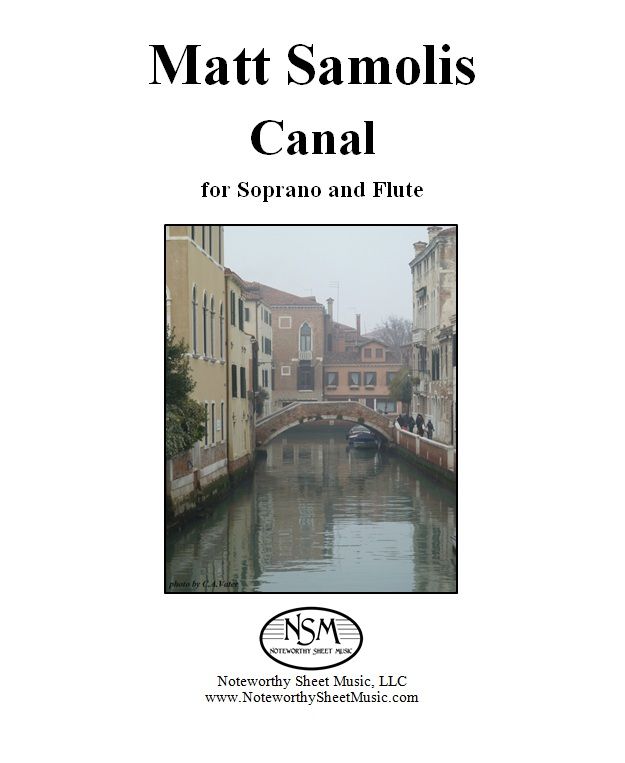 Canal, by Matt Samolis
Canal, by Matt SamolisContemporary Composition for Soprano and Flute, PDF $13.95
Matt Samolis began studying flute, then later composition and tenor banjo. He has worked with ensembles at New England Conservatory, Brandeis University, and Tufts University, as well as Open Hand Theatre, Pilgrim Research Collaborative, and numerous other projects. Currently, his primary focus is composition, curating, and performing as a flutist with various local groups, as well as his drone alliance, The Metal & Glass Ensemble.
Canal is written in a free, self referential style, and uses the text of Roy Campbell's poem of the same name, written in 1920. Despite the somber text, the mood is idyllic and somewhat reminiscent of the contemporary musical language in use at that time. Each player also has a brief ad lib section, where they can interpret the material as they choose.
Click to listen to two snippets of an audio recording of Canal, performed by soprano Noell Dorsey and composer/flutist Matt Samolis:
 Canal Owlseyes
Canal Owlseyes  Canal Whiteflame
Canal WhiteflameOr listen to the full recording on Matt's website.
Score for Soprano and Flute, 5 pages; Total, 7 pages.
Preview==============================================
US customers may purchase professionally-printed hard copies of Canalfrom Noteworthy Sheet Music for $20.93 plus a $5.95 shipping and handling fee. Please use the Contact Us form to let us know which print edition(s) you would like to purchase, along with your contact information and your USPO mailing address.
-
Samolis - Duo for Two Flutes - Flutes
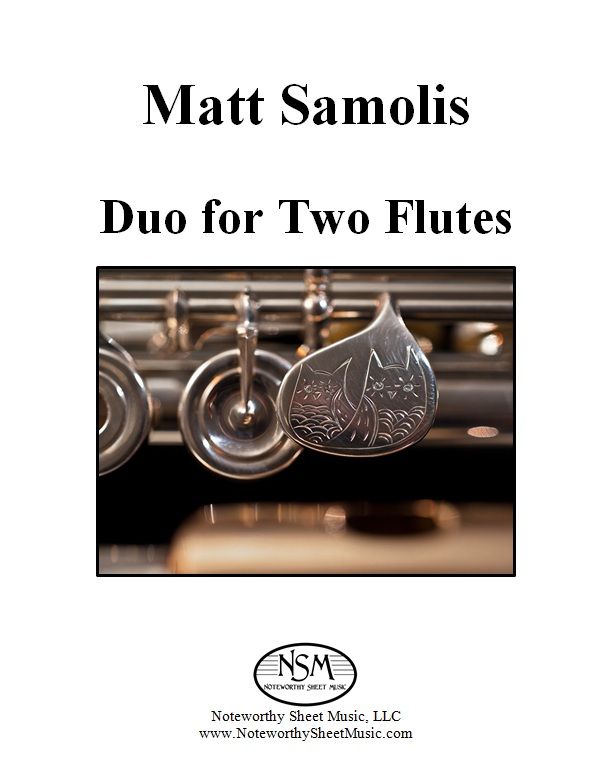 Duo for Two Flutes, by Matt Samolis
Duo for Two Flutes, by Matt SamolisContemporary Composition for Two Flutes, PDF $17.99
Duo for Two Flutes was written using twelve tone techniques. The original tone row was divided in half, with each set of six tones being used to generate one of the flute parts. Frequently changing time signatures reflect compositional organization of the pitches, and does not establish meter. The piece has a playful, somewhat mechanical feel.
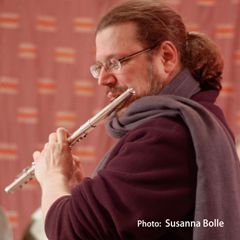 To listen to bits of a recording of Duo for Two Flutes performed by Matt Samolis and Peter H. Bloom, click on the icons below.
To listen to bits of a recording of Duo for Two Flutes performed by Matt Samolis and Peter H. Bloom, click on the icons below.Score for Two Flutes, 8 pages; Total, 11 pages.
Preview -
Schnauber - A Little Grand Wedding March Waltz - Piccolo and Trombone
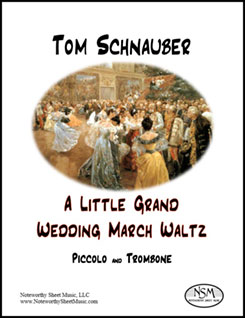 A Little Grand Wedding March Waltz, by Tom Schnauber
A Little Grand Wedding March Waltz, by Tom SchnauberScore for Piccolo and Trombone, PDF $4.99
This piece was written for the wedding of two good friends of mine from graduate school. One was a trombonist and the other a piccolo specialist. It was conceived in the lovely tradition of Hausmusik: short, simple, fun, and meant for two people to play with each other or for friends. Also, though the score indicates trombone and piccolo, it should be equally satisfying with a cello or bassoon on the lower part and a standard flute on the upper. Or even contrabassoon and piccolo . . . whatever you have available. —Tom Schnauber
Score, 3 pages; Total, 4 pages
Preview -
Schnauber - Not-Pooh Songs - Female Voice and Flute or Female Voice and Oboe
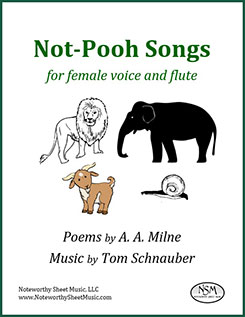 Not-Pooh Songs, by Tom Schnauber
Not-Pooh Songs, by Tom SchnauberFor Female Voice and Flute or Female Voice and Oboe, 2 editions
Score for Female Voice and Flute, PDF $18.46
Score for Female Voice and Oboe, PDF $18.46Tom Schnauber’s Not-Pooh Songs are absolutely delightful. The composer has set to music six children’s poems by A. A. Milne, four from When We Were Very Very Young (“The Alchemist”, “The Mirror”, “The Four Friends”, and “If I Were King”) and two from Now We Are Six ("The Charcoal Burner" and "The Engineer"). The work is offered by Noteworthy Sheet Music, LLC in two publications, one for female voice and flute, the other for female voice and oboe. The oboe line is sufficiently different from the flute line in terms of register to warrant it being published as a separate edition (i.e., the flute version makes use of that instrument’s wider range by putting some material in higher octaves). Also, the flute edition includes an alternate variation of “The Mirror” for voice and alto flute, whereas the oboe edition includes an alternate variation of “The Mirror” for voice and English horn.
It’s clear from hearing this music that Schnauber gets a real kick out of Milne’s poetry. The flute/oboe comments, echoes, etc. go with or against the voice line very effectively and entertainingly. These songs will have broad appeal to both players and audiences, and there’s a lot that a pair of performers could do with them. The music isn’t easy, but provides just the sort of challenges that the adventuresome player loves; in places, for example, the flute jumps from C7 to C4, plays multiphonics, and executes finger snaps. But, as the composer has pointed out, just because the music is somewhat demanding doesn’t mean that it should be presented seriously in performance; on the contrary, players should have fun with these pieces and convey the intended joy and playfulness of the work.
Note that both performers are to play from the score, so flutists and oboists may want to print their copy of the score single-sided to avoid a few difficult page turns.
To listen to a recording of Not-Pooh Songsperformed by Mitsi Westra, voice, and Pamela French, oboe, visit Tom Schnauber’s SoundCloud page at https://soundcloud.com/user-557772917/sets/not-pooh-songs.
► Schnauber - Not-Pooh Songs - Voice and Flute - PDF
 Preview: Not-Pooh Songs for Voice and Flute, p1
Preview: Not-Pooh Songs for Voice and Flute, p1Score for female voice and flute, 22 pages; Lyrics, 2 pages; Total, 28 pages.
► Schnauber - Not-Pooh Songs - Voice and Oboe - PDF
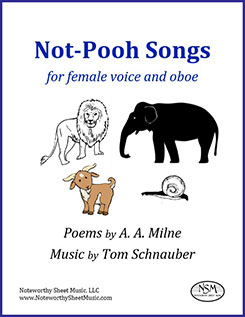 Preview: Not-Pooh Songs for Voice and Oboe, p7
Preview: Not-Pooh Songs for Voice and Oboe, p7 Score for female voice and oboe, 22 pages; Lyrics, 2 pages; Total 28 pages
Front cover images courtesy of Wikipedia.org, Wikimedia.org, and Free Vector Snail Clip Art; Asian Elephant and Lion files are made available under the Creative Commons CC0 1.0 Universal Public Domain Dedication.
- Elephant: author: Shyamal, https://en.m.wikipedia.org/wiki/File:Asian_Elephant_Icon.svg
- Lion: author: openclipart.org, https://commons.wikimedia.org/wiki/File:Lion_clipart.svg
- Goat: released into the public domain by its author, LadyofHats. https://commons.wikimedia.org/wiki/File: Goat_cartoon_04.svg
- Snail: Free Vector Snail Clip Art: Snail Clip Art is a completely free picture material, which can be downloaded and shared unlimitedly.
https://www.seekpng.com/ipng/u2q8y3t4a9e6a9q8_free-vector-snail-clip-art-snail-clip-art/ -
Schnauber - Those Infernal Exsanguinators - Flute and Piano
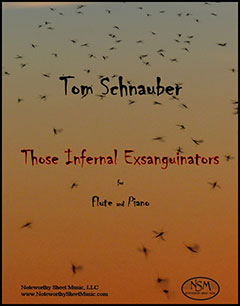 Those Infernal Exsanguinators, by Tom Schnauber
Those Infernal Exsanguinators, by Tom SchnauberFlute part and Piano score, PDF $17.97
Summer in Minnesota. The sun is setting, the broad sky is clear, and the cool light of dusk promises a welcome respite from the day’s heat and humidity. You step out into the stillness and stand, gazing at the orange-red horizon, thankful for the dimming light and approaching night. And then they come. Those insidious little creatures, those vile insects that define and destroy the season: the mosquitoes. Only some at first, few enough to make you think that if you swat them away, you can still enjoy the evening air. But then more come, and more, and even more. They whine, you moan, they sting, you slap, they swarm, you flail. Soon, your body a mass of swelling welts, you realize that the twilight peace you had hoped for when you left your house is a sham, an impossible illusion shattered by the piercing terror of those infernal exsanguinators. Angry and itching, you run back inside and slam the door shut. —Tom Schnauber
In October, 2020, we at NSM were delighted to welcome Tom Schnauber as one of our contributing contemporary composers; click the link to read about this acclaimed composer's career and his many exciting projects.
Those Infernal Exsanguinators is a compelling piece; to discover this for yourself, please visit Tom Schnauber's soundcloud page and listen to arecording of the work beautifully performed by Tamara Thweatt, flute, and Hey-Seon Choi, piano.
Piano Score, 18 pages; Flute part, 7 pages; Total, 28 pages.
Preview